

LG Inform. Systems Science/Context Diagram. System of Systems Methodologies (SOSM) From SystemsWiki While developing the Systems Thinking Definitions there was an awareness of other Systems Sciences and I continued to ask myself how it all fit together.
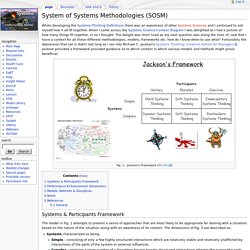
When I came across the Systems Science Context Diagram I was delighted as I had a picture of how many things fit together, or so I thought. Ssm.pdf. Habits of a Systems Thinker - Waters Foundation. The Habits of a Systems Thinker describe ways of thinking about how systems work and how actions taken can impact results seen over time.
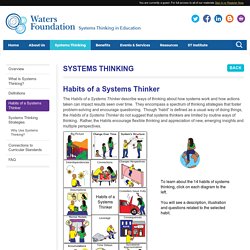
They encompass a spectrum of thinking strategies that foster problem-solving and encourage questioning. Though “habit” is defined as a usual way of doing things, the Habits of a Systems Thinker do not suggest that systems thinkers are limited by routine ways of thinking. Rather, the Habits encourage flexible thinking and appreciation of new, emerging insights and multiple perspectives. Cybernetics and Circularity: The Heinz von Foerster Aphorisms. The late Heinz von Forster was a founder of Cybernetics along with McCulloch, Wiener and von Neumann.

As Director of the Biological Computer Laboratory from 1958-1975 at University of Illinois he was a leading supporter of the pioneer English Cyberneticians working with Alex Andrew, Gordon Pask and Ross Ashby. There is a great deal of material about Heinz on the web. A taste of his writing can be found courtesy of the International Society for the System Sciences (ISSS) In 1995 the American Society for Cybernetics Annual Conference in Chicago took as its theme "Circularity". Thinking about Systems. Van-Caspel-MT-VSM-as-a-Tool-for-Organizational-Change-a-Critical-Examination.pdf. The Bridge: Framing: Differences of Kind and Degree. You Innovate with Your Heart, Not Your Head. I recently got a call from a CEO of a health system that encompasses several hospitals, medical practices, and clinics.

Lakeland Health employs about 4,000 associates and takes in nearly $500 million per year. Its facilities are spread across the southwest corner of Michigan — where median income is 70% of the national average and the incidence of chronic diseases is substantially higher than the norm. Leader to Leader Journal - Article Print Page. Bridges' Transition Model - Change Management Tools From MindTools.com. Guiding People Through Change © iStockphotobo1982 People are often quite uncomfortable with change, for all sorts of understandable reasons.
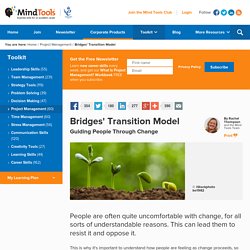
This can lead them to resist it and oppose it. Your Organization Needs to Change its Strategy Implementation Method. Accelerate! Perhaps the greatest challenge business leaders face today is how to stay competitive amid constant turbulence and disruption.

Any company that has made it past the start-up stage is optimized for efficiency rather than for strategic agility—the ability to capitalize on opportunities and dodge threats with speed and assurance. I could give you 100 examples of companies that, like Borders and RIM, recognized the need for a big strategic move but couldn’t pull themselves together to make it and ended up sitting by as nimbler competitors ate their lunch.
The examples always play out the same way: An organization that’s facing a real threat or eyeing a new opportunity tries—and fails—to cram through some sort of major transformation using a change process that worked in the past. Intensionality vs. Intentionality. Department of Computer Science and Engineering, Department of Philosophy, and Center for Cognitive ScienceState University of New York at Buffalo, Buffalo, NY14260-2000 Background When I was in grad school in philosophy, I encountered two terms that I knew were being used in technical senses: "intensional"/"intensionality" (with an "s") and "intentional"/"intentionality" (with a "t").
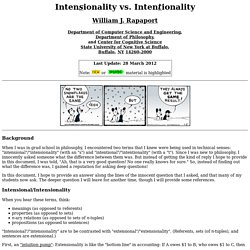
Since I was new to philosophy, I innocently asked someone what the difference between them was. But instead of getting the kind of reply I hope to provide in this document, I was told, "Ah, that is a very good question! No one really knows for sure. " In this document, I hope to provide an answer along the lines of the innocent question that I asked, and that many of my students now ask. Properties. 1.

Distinctions and Terminology 1.1 Properties: Basic Ideas Not all philosophers acknowledge properties in their ontological inventory and even those who agree that properties exist often disagree about which properties there are. Outcome Driven Design. The Policy Framework for Investment (PFI) About the Policy Framework for Investment The Policy Framework for Investment (PFI) is the most comprehensive and systematic approach for improving investment conditions ever developed.
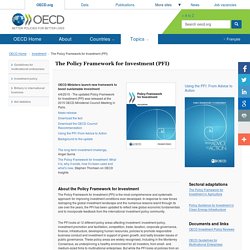
In response to new forces reshaping the global investment landscape and the numerous lessons learnt through its use over the years, the PFI has been updated to reflect new global economic fundamentals and to incorporate feedback from the international investment policy community. The PFI looks at 12 different policy areas affecting investment: investment policy, investment promotion and facilitation, competition, trade, taxation, corporate governance, finance, infrastructure, developing human resources, policies to promote responsible business conduct and investment in support of green growth, and lastly broader issues of public governance.
The PFI is neither prescriptive nor binding. Who uses the PFI? The PFI also provides a basis for support on regional investment policy dialogue. The Atlas of Economic Complexity. The Growth Lab The Growth Lab is an academic research program run out of Harvard’s Center for International Development (CID).
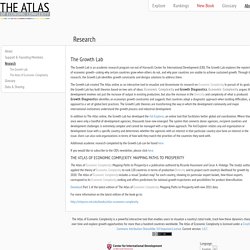
The Growth Lab explores the mysteries of economic growth—asking why certain countries grow when others do not, and why poor countries are unable to achieve sustained growth. Through its research, the Growth Lab identifies growth constraints and designs solutions to address them. The Growth Lab created The Atlas online as an interactive tool to visualize and disseminate its research on Economic Complexity. Hausmann and Hidalgo find wealthier economies are also more complex. A truism about the benefits of international trade holds that countries that specialize in producing goods that they are best at manufacturing will enjoy the greatest prosperity.
But a recent study of economic complexity provides a different take on the wealth of nations. Using “network science,” a method of analysis that examines webs of connections in complex systems, Ricardo Hausmann, professor of the practice of economic development and director of Harvard’s Center for International Development, and CID research fellow César Hidalgo, a physicist by training, have shown that the richest countries are those with the most complex economies—and actually produce the greatest diversity of goods. “Firms and individuals specialize, countries diversify,” emphasizes Hausmann. Why is complexity correlated with wealth? Green growth indicators. OECD green growth indicators in practice The Green Growth Indicators 2014 updates the 2011 Towards Green Growth: Monitoring progress. It presents the OECD framework for monitoring progress towards green growth and a selection of updated indicators that illustrate the progress that OECD countries have made since the 1990s.
Moreover, countries like Slovenia, the Czech Republic, Denmark, Germany, Korea, the Netherlands and the Slovak Republic have already applied and adjusted the OECD green growth measurement framework and indicators to their specific national contexts to assess their state of green growth. The truth about smart cities: ‘In the end, they will destroy democracy' A woman drives to the outskirts of the city and steps directly on to a train; her electric car then drives itself off to park and recharge. A man has a heart attack in the street; the emergency services send a drone equipped with a defibrillator to arrive crucial minutes before an ambulance can. A family of flying maintenance robots lives atop an apartment block – able to autonomously repair cracks or leaks and clear leaves from the gutters. Such utopian, urban visions help drive the “smart city” rhetoric that has, for the past decade or so, been promulgated most energetically by big technology, engineering and consulting companies.
Yet there are dystopian critiques, too, of what this smart city vision might mean for the ordinary citizen. Time to kill the phantom 70% failure rate quoted on transformational strategy? Time to kill the phantom 70% failure rate quoted on transformational strategy? November 16, 2013, 10:18 am Filed under: - Change Execution, - Organization Change Management, - People Change Management, - Project Management, - Strategy and Imperatives, - Strategy Execution | Tags: Change Management, Management Consulting, ROI, Strategy, Transformation.
Abstraction: Achieving Alignment At 10,000 Feet - Enterprise Architects. Have you ever attempted to align two ‘high level’ models? Sure there are likely to be features they both have in common – but then there is likely to be the rest of the model where things have been grouped differently, rolled up into different categories or described at differing levels of detail. Changing change management. Change management as it is traditionally applied is outdated. Juggling conflicting purposes for system maps. Where to intervene in a system. Primer Welcome. 1980's: Naval Education and Training Tapes. Magic Quadrant for Enterprise Architecture Consultancies. 24 June 2015 ID:G00276891. Global City Indicators Facility.
Implementing a citizen-centric approach to delivering government services. Delivering services to citizens is at the heart of what most government agencies do. Business Capability Redefined According to SMACT. Going beyond ‘context matters’: A lens to bridge knowledge and policy. COMPLEX ORGANIZATIONS. OECD report: From Transactional to Strategic: systems approaches to public service challenges. [Apparently this report was released in final version on 11 April, but I can only find the ‘alpha’ - so here it is] Summary. For whom the budget cut tolls. Bill Below, OECD Directorate for Public Governance Staff reductions, salary cuts, the loss of benefits and truncated career opportunities blow a cold wind over the motivation of employees fortunate enough to survive downsizing. Managing Government, Governing Management. The Systems Thinker – The Systems Thinker - Systems thinking approaches. Repenning Sterman CMR su01. Developing Your Capability Architecture: It’s All About Being Able to Get Things Done - IRM Connects, by IRM UK.
Toolkits for transdisciplinary research. Metamodernism in Five Terrible Diagrams – Seth Abramson – Medium. Collste Abstract. Three schools of transformation thinking. Policy Design Lab – + policy tools wiki. Developing your Capability Architecture: It's All about Being Able to Get Things Done (Commentary) Home. Business Architecture - A New Depiction. The 5 Product Levels Model (Kotler) - Forum. Maslow’s Hierarchy of Needs vs. The Max Neef Model of Human Scale development. Needs & Public Policy.
Society & Governance. Cities. Shared Services. Enterprise Strategy/Planning. Enterprise Architecture & Design. Enterprise Culture. Enterprise Transformation. Ecosystem Architecture. Other Architectures. Systems Thinking. Sensemaking. Generating Ideas. Classifying. Visualizing. Modeling. Measuring. Analyzing & Designing. Collaborating. Method Compilations. Ologies.